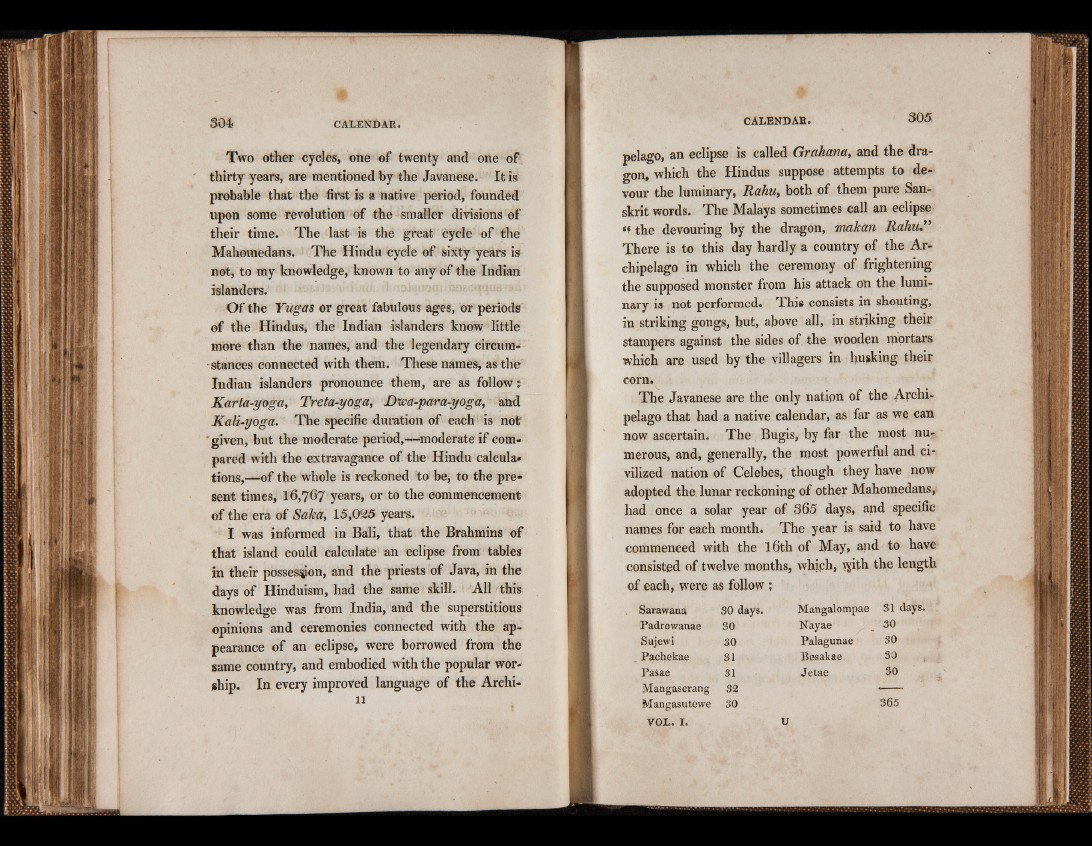
Two other cycles, one of twenty and one of
thirty years, are mentioned by the Javanese. It is
probable that the first is a native period, founded
upon some revolution of the smaller divisions of
their time. The last is the great cycle of the
Mahomedans. The Hindu cycle of sixty years is
not, to my knowledge, known to any of the Indian
islanders.
Of the Yugas or great fabulous ages, or periods
of the Hindus, the Indian islanders know little
more than the names, and the legendary circumstances
connected with them. These names, as the
Indian islanders pronounce them, are as follow:
Karta-yoga, Treta-yoga, D'wa-para-yoga, and
Kali-yoga. The specific duration of each is not’
given, but the moderate period,—moderate if compared
with the extravagance of the Hindu calculations,—
of the whole is reckoned to be* to the present
times, 16,767 years, or to the commencement
of the era of Saka, 15,025 years.
I was informed in Bali, that the Brahmins of
that island could calculate an eclipse from tables
in their possesion, and the priests of Java, in the
days of Hinduism, had the same skill. All this
knowledge was from India, and the superstitious
opinions and ceremonies connected with the appearance
of an eclipse, were borrowed from the
same country, and embodied with the popular worship.
In every improved language of the Archill
pelago, an eclipse is called Grahana, and the dragon,
which the Hindus suppose attempts to devour
the luminary, Rahu, both of them pure Sanskrit
words. The Malays sometimes call an eclipse
4 the devouring by the dragon, makctn Rahu**
There is to this day hardly a country of the Archipelago
in which the ceremony of frightening
the supposed monster from his attack on the luminary
is not performed. This consists in shouting,
in striking gongs, but, above all, in striking their
stampers against the sides of the wooden mortars
which are used by the villagers in baking their
corn.
The Javanese are the only natipn of the Archipelago
that had a native calendar, as far as we can
now ascertain. The Bugis, by far the most numerous,
and, generally, the most powerful and civilized
nation of Celebes, though they have now
adopted the lunar reckoning of other Mahomedans,
had once a solar year of 365 days, and specific
names for each month. The year is said to have
commenced with the 16th of May, and to have
consisted of twelve months, which, vyith the length
of each, were as follow ;
Sarawana SO days. Mangalompae SI days.
Padrowanae SO Nayae 30
Sujewi 30 Palagunae 30
Pachekae 31 Besakae SO
Pasae 31 Jetae 30
Mangaserang 32 ------
Mangasutewe 30 365
VOL. I. U